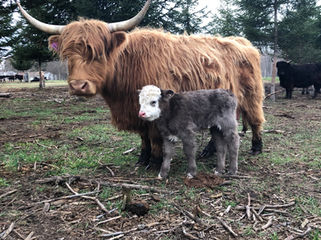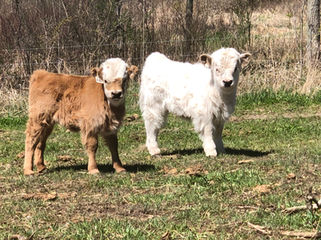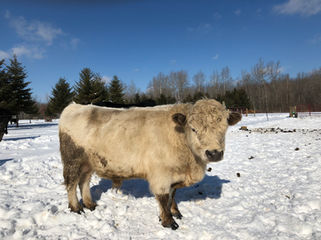Miniature Highland Cattle
Miniature to Midsize Highland/Highpark/Highshire Cattle

2 Men & A Hen decided in the summer of 2018 to begin a breeding project for miniature highland cattle.
Details of the project are outlined below including pictures of our foundation stock.
We acquired our foundation heifers and cows from three sources in Michigan. Five 100% highland heifers came from midsize miniature stock (42"-48"). Three heifers came from a breeder with highlands and dexter cattle. These three heifers are 50%, 50%, and 75% highland and are chondro negative. We acquired 5 more 100% cows 5-13 years old from a farm in Alpena. Our bull (Parker) was sourced from Hans & Sheril Peterson in Lakeport MI. He carries the white park gene and the dexter chondrodysplasia (BD1) gene and is 62.5% highland. We specifically chose these cattle to start our miniature highland project because of their conformation, size, and availability.
In 2018 it was extremely difficult to acquire miniature highland cattle of good stock at a respectable price. Miniature highlands are selling for $3000 - $10,000 each and are extremely difficult to find. We spent a significant amount of money on Parker as he is a miniature and carriers the Highpark and Highshire coloration along with the chondro gene all of which we want to be prominent in our herd.
Our intention with our miniature highland project is to breed Parker to our foundation girls and keep all of the daughters especially focusing on those that carry the BD1 gene and white park traits. Our focus for conformation is that our cattle are small enough to be classified as miniature but are still beefy enough to bridge the meat market. We do not want our cattle to be so small they are useless.
The chondrodysplasia gene (BD1) shrinks cattle by 4"- 6" and is easily managed in a herd with a responsible breeder. BD1 also improves temperament in cattle making them more docile and friendly. BD1 is a dominate genetic trait that results in the death of cattle that are genetically homozygous for BD1. Approximately 25% of calves from BD1 positive x BD1 positive are homozygous BD1 and are still born. To prevent homozygous BD1 in cattle it is imperative that BD1 carrying cattle are bred to non-BD1 carrying cattle. Which results in 100% viable calves 50% of which carry the BD1 gene.
While building a miniature highland herd using the BD1 gene it is important to realize that this alone will only make 50% of cattle born miniature and is not an effective method of breeding miniature cattle. This is why Parker as well as every future herd sire must be genetically small without the BD1 gene. Parker is the foundation of our herd and will breed all of our miniature and midsize miniature highland cows. The offspring from these breedings even without the BD1 gene should bring us very close to miniature classification which is 36"-42" at three years of age. Our BD1 heifers sired by Parker and bred to a 100% miniature highland should produce miniature calves all of the time and may even begin producing micro miniature calves (less than 36").
Highpark and Highshire coloring. Highpark coloring in our herd comes from Parker's mother Elsa 50% mini highland/50% mini white park. Highpark coloring includes colored ears, colored feet and occasionally colored spots with a white overlay. Highshire coloration in our herd comes from Parker's father Sven. Sven is 75% mini highland/ 25%mini Kentshire (Hereford/Dexter). Highshire coloration comes from Hereford genetics and includes white face markings.























